



HOW TO TRAIN A DRAGON
FOR MEMBERS AND WILDLIFE LOVERS SPRING 2024
wildabout
Sulawesi crested macaques Khaleesi the Komodo dragon
IT MUST BE LOVE

DOUBLE TROUBLE
What could be better than one baby gorilla? That’s right, TWO baby gorillas!
Earlier this spring, London Zoo celebrated the birth of two gorillas –born to mums Mjukuu and Effie within a month of each other.

It might be a while yet until the pair are best friends though, says Kathryn Sanders, Head of Primates and Predators. “Gorillas develop almost as slowly as human babies and spend the first six months being carried everywhere on mum’s tummy. Around the six-month mark gorilla babies will learn to crawl and then walk – it’s at this time that we can look forward to the pair interacting together. At a year old they’ll switch to riding around on mum’s back!”
Western lowland gorillas are Critically Endangered in the wild, which makes their births doubly special – or is that quadruply special? One thing’s for sure: Gorilla Kingdom’s silverback Kiburi is one proud father!

WILD ABOUT / SPRING 2024 2

Wild About is the magazine for Gold Members, Fellows and Patrons of London and Whipsnade Zoos
London Zoo, Regent’s Park, London NW1 4RY
Tel: 020 7722 3333 zsl.org
Registered Charity No. 208728
For more information about Membership, please contact our supporter contact team on 0344 225 1826.
Editor: Jonathan Kemeys
Design: Suzie Black/Alliance Creative wildabout@zsl.org
With thanks this issue to: Alice Adams, Will Amlot, Laura Birch, Tyrone Capel, Joe Capon, Sophie Common, Stephanie Deas, Gemma Dipple, Emma Edwards, Hannah Fisk, Sarah Forsyth, Matthew Gould, Charlotte Gurden, Joy Hadfield, Jo Iredale, Lauren Johnson, Aimee Louise and family, Claire McSweeney, Mike Newman, Carolin Pockrandt, Chelsea Reid-Johnson, Natasha Roche, Vicki Sage, Kathryn Sanders, Tim Wacher, Gary Ward, Matthew Woolf.
Wild About is printed on paper certified by the Forest Stewardship Council (FSC) and contains elemental chlorine free (ECF) fibre, which comes from wellmanaged forests. Your copy of the magazine is sent to you in a recyclable envelope. Wild About is published three times a year and distributed to Gold Members and supporters. No part of Wild About may be reproduced or used in any form or by any means, either wholly or in part, without prior written permission from ZSL. ZSL cannot guarantee the return of unsolicited articles, photographs, etc. ZSL reserves the right to refuse an advertisement without explanation. ZSL does not necessarily endorse any of the products or services advertised. When you have finished with this issue please recycle it or share it!
THE BIG OPENING
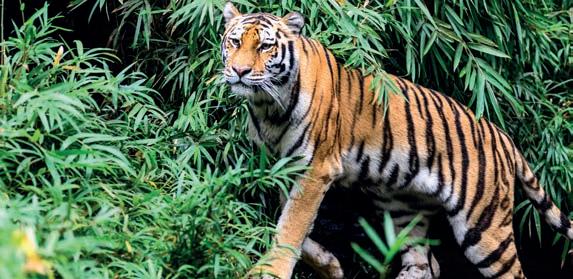
Spring is traditionally a time for births and new beginnings. At the Zoos, this couldn’t be more apt – among many births across both Zoos, Gorilla Kingdom is currently home to two beautiful babies, two very proud mums and one surprisingly chilled dad. And we’re getting ready for the opening of two of our most ambitious animal habitats yet: The Secret Life of Reptiles and Amphibians at London Zoo and Monkey Forest at Whipsnade Zoo.
As is sometimes the way with ambitious projects, we did hit some snags with The Secret Life of Reptiles and Amphibians that caused frustrating delays, so I’m delighted that we’re finally going to be able to enjoy it. Both animal habitats will care for species that are at risk of going extinct in the wild, and provide incredible experiences for our visitors. On your visits, you’ll learn about the challenges facing these species –including disease, deforestation and the pet trade – and what we can do to help fight these threats.
Caring for these animals in zoos is an integral part of our mission – we not only give homes to species that might not have a safe one elsewhere, we provide the starting blocks for returning them to the wild. On pages 4 and 5, you’ll read about some of our successes in the field that would have been impossible without zoos: the return of scimitar-horned oryx to Chad, a shipment of several thousand
READ ABOUT HOW WE’RE ON PAGES 14 AND 15 SAVING TIGERS IN NEPAL
extinct tree snails to French Polynesia, and our trials of radio tracking technology with Vietnam pheasants. On pages 14 and 15, you’ll also read about how we’re saving tigers in Nepal. For the past century, the decline of tigers has made sad reading, and it appeared they were on their way to extinction. However, in Nepal, we finally have good news – tiger numbers are actually growing. The numbers are still a fraction of what they were, but we know now that we have a model for success that could work in other countries.
You may be surprised to learn that conserving tigers is as much about helping people as it is protecting tigers themselves. In fact, one very often leads to the other. It can be as small as distributing induction stoves in villages on the edges of national parks. These simple items remove the need for firewood, reducing trips into the forests for local people, where they could encounter tigers.
Not only is your membership funding the care of our Zoo animals, it’s going into initiatives like these around the world – helping people and saving tigers. Thank you.
 Matthew Gould, CEO, ZSL
Matthew Gould, CEO, ZSL

3
WILD ABOUT / AUTUMN 2023


ORYX ON THE UP
At the end of 2023 we celebrated some incredible news – the scimitar-horned oryx has been downlisted from Extinct in the Wild to Endangered.
The news officially recognises their successful return to the wild after years of reintroductions. The species was declared Extinct in the Wild in 2000 by the International Union for Conservation of Nature.

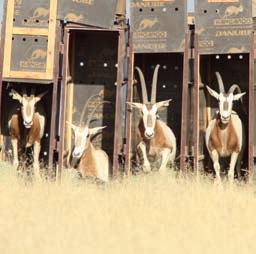
Since their disappearance, our conservationists have been working alongside the Government of Chad, the Environment Agency of Abu Dhabi and Sahara Conservation to return the rare oryx to their home on the edge of the Sahara Desert. Long-time Wild About readers may even remember reading about the project in 2017, when the reintroductions began!
Whipsnade Zoo also played an important part in their return – in 2014, we sent two females to Abu Dhabi, to join 23 oryx bred at other zoos, to help establish a herd of oryx for reintroduction to the wild. A decade later and a whopping 600 oryx are living wild in Chad!
OF ORYX INTO HOLDING ENCLOSURE 20
We care for 20 Extinct in the Wild species and subspecies. That’s more than any institution in the world!
WILD ABOUT / SPRING 2024 4
TEAM IN THE FIELD
CHADIAN MONITORING
RELEASE
TAIL-FEATHER TRACKER TRIAL
The last sighting of a wild Vietnam pheasant was recorded in 2000, and the bird is thought to be extinct in the wild – due to habitat loss and overhunting.
Now, plans are underway for a reintroduction to the wild, supported by some of the 450 birds cared for in European zoos. They will join birds at Hanoi zoo to start a breeding centre of pheasants, for a future reintroduction.

“Thick jungle and mountains will make it extremely difficult to find the birds and check how they are doing, so we need to develop a tracking system,” explains Gary Ward, our Curator of Birds. “The Vietnam pheasants at our Zoos are helping us to trial radio trackers attached to the tail feathers.”
The trackers weigh just 6g, and are attached to the central tail feather by a method already used with our flying demonstration birds at ZSL’s Zoos. They are considered safer than radio collars, as they are less likely to get caught in thick jungle.
Look out for Vietnam pheasants in London Zoo’s Bird Safari and see if you can spot the their tail trackers!
PRECIOUS ESCARGOT LANDS IN TAHITI

In autumn 2023, a clutch of Extinct in the Wild tree snails landed in Tahiti. Escorted the whole way by Tyrone Capel, Whipsnade’s Partula Keeper, the 3,000 Partula tree snails journeyed over 15,000 kilometres, through 10 time zones, to reach their new home in French Polynesia.
Zookeepers at London Zoo and Whipsnade Zoo have been carefully and tirelessly breeding the tree snails for the last thirty years, which disappeared from French Polynesia in the 1980s. In 2015, we were finally ready to begin a reintroduction programme, and since then we – along with several other UK zoos – have returned a whopping 24,000 snails to the wild.


DOWNLOAD THE LONDON AND WHIPSNADE ZOO APPS
Before your next visit, download our new Zoo apps and let us help you get the most out of your day. Both apps contain a schedule of daily talks, and the handy ‘Plan Your Day’ feature creates a bespoke schedule with all the animals and talks you want to see and hear. For animal addicts keen to learn more about the species they love, or discover new species, the apps contain mini guides to many of our iconic animals. And for moments when you’re caught short, need a cake break or have an urgent play area request, our GPS-enabled map and navigation has got you covered.


To download, search London Zoo or Whipsnade Zoo on your chosen app store.
“Before the release, local people told us stories about the abundance of the snails decades ago, and showed us traditional shell necklaces from before the extinction. They asked for some of the snails to be released near their land so they could keep an eye on them,” says Tyrone. “Watching beaming locals, and the snails I had helped care for slowly propel themselves into the canopy, has been the proudest moment of my career.”
Partula snails are only found on French Polynesia, and began to decline in the 1980s. They were being eaten by a carnivorous snail, called the rosy wolf snail, that had been released on the islands to curb a growing population of African land snails, who themselves had been introduced to the islands to be used as a food source. But instead of the rosy wolf snails feeding on their intended prey, the African land snails, they started feasting on the smaller and slower Partula snails.


5 WILD ABOUT / SPRING 2024
TYRONE CAPEL (LEFT) MEETS LOCALS TO DISCUSS PARTULA SNAILS
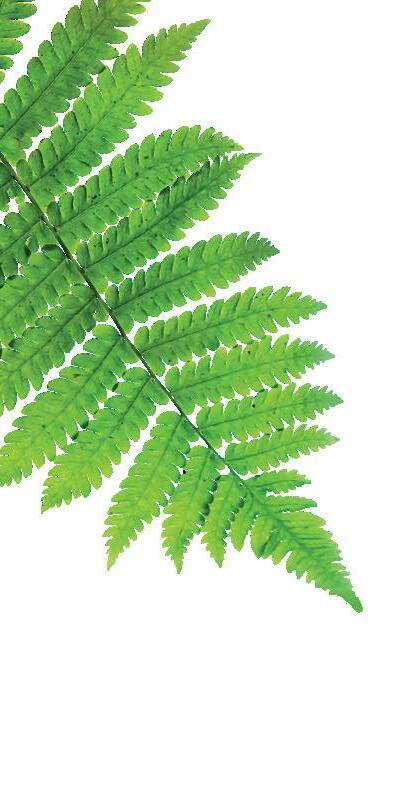
IT MUST BE LOVE
They spend a significant part of their day grooming or cuddling up.

habitat, Monkey Forest.
Good grooming is a big deal in the primate world. And there are no more enthusiastic groomers than Sulawesi crested macaques, the newest species to move in at Whipsnade Zoo.
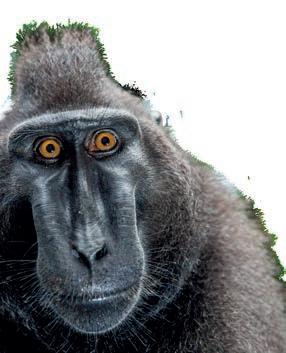
No, we’re not talking about brushing their teeth regularly, or treating themselves to a pedicure once a month. We mean social grooming – sitting down with friends and family to comb through their fur for tasty grubs and dead skin.
“Sulawesi macaques are extremely affectionate with each other. They spend a significant part of their day grooming or cuddling up,” says Sarah Forsyth, Curator of Mammals at London and Whipsnade Zoos. “A male might lie down and have two female macaques groom him for hours on end – before switching places.”
As well as the hygiene benefits of a regular clean, social grooming is an important bonding technique for primates. “Getting a scratch from another macaque in a spot you just can’t reach is a sure way to build trust, or to patch up after an argument.”
We don’t want to give you the impression our macaques are total loafers though – far from it!

Macaques are an extremely intelligent species of primate says Sarah – it’s an evolutionary adaptation to living in large groups on the Indonesian island of Sulawesi. “Primate society is a complicated business, largely based on body language and facial expressions – all of which need to be interpreted correctly.” In short, big communities need big brains.
Macaques are fruit-eaters and spread seeds in their droppings, making them vital to maintaining Sulawesi’s rainforest
GOLDEN NUGGETS
WILD ABOUT / SPRING 2024 6

It’s in the name
Monkey Forest lives up to its name. The new area incorporates a woodland of over 100 trees – including beech, sycamore and oak – providing the perfect habitat for our macaques to clamber in. The new homes give unrivalled viewing for visitors, who will have access to indoor viewing areas and a new outdoor trail running alongside Passage Through Asia. Sunken fences and raised viewing spots along the trail will provide uninterrupted views of our macaque troop and anoas.

Super troop
Males are almost twice the size of females and have large canine teeth, which they use to warn off other males
SAY CHEESE
Monkey Forest will be the largest macaque habitat in the UK and macaques will be coming from across the country to form one super troop.
“We’re starting with 14 macaques, including the four from London Zoo, but our hope is to grow our group to 30 individuals, to make use of the incredible facilities we now have here,” explains Sarah. “Because they’re so rare in the wild we want to build up their population in zoos to protect their future.”

Anoas need to be small and stealthy to navigate lush Indonesian rainforest.
DEMONS OF MONKEY FOREST
Our forest is also welcoming another rare creature from Sulawesi: the lowland anoa.
Anoas are a small species of buffalo – in fact, they’re the smallest of all wild cattle species, standing at less than a metre tall – but are known as ‘the demon of the forest’ on Sulawesi. They get the nickname for the way they move stealthily through the forest and how feisty they can be when threatened.
Their size and behaviour are adaptations to their environment, says Sarah. “Anoas need to be small and stealthy to navigate lush Indonesian rainforest. Their big attitude is down to not living in herds like many other cattle. They live solitary lives and have to be able to defend themselves in the jungle.”
Putting their attitude aside, we think anoas could win a competition for world’s most beautiful bovine – so we can only hope for the patter of miniature hooves. “If our male and female hit it off we could have a calf very soon,” says Sarah. “They’re an extremely rare species – less than 2,500 are thought to remain in the wild – and our new group will be an important addition to the breeding programme.
“Housing macaques and anoas together is a great way to provide natural stimulation to both species, double the number of threatened species we can care for in one place and make full use of the forest habitat,” adds Sarah.
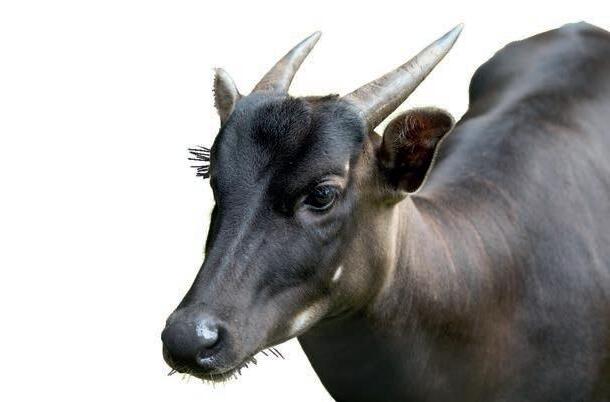
7 WILD ABOUT / SPRING 2024
SPECIES YOU MIGHT HAVE MISSED
Even the most eagle-eyed of members might have missed these hidden gems. Can you track them down on your next visit?


Marabou stork
These giant birds can grow to the height of a human and have a wingspan of three metres. Just like vultures, marabou storks are a bit misunderstood –they even have the nickname the ‘undertaker bird’. OK, so they feed on dead things, but this helps stop the spread of disease in the wider ecosystem.
So we say more underdog than undertaker. And with their massive bills and stately manner they are quite endearing really.
Find me: By Base Camp Restaurant. Come see me at 3pm, during my daily training sessions.
Vampire crab
Named for their spooky eyes rather than any bloodsucking habits, these crabs are native to Indonesia. They live in freshwater rivers, rather than the ocean, but spend a lot of time foraging on land and have adapted gills that allow them to breathe in both environments.
Find me: In the Butterfly House. Look out for me blowing bubbles when I’m on land, I do this to keep oxygen flowing to my gills.

Emei Shan liocichla
Full marks if you spot this one! This brightly coloured bird (pronounced ‘Emmy Shan LeoSickler’), is named after Mount Emei (‘shan’ means mountain in Chinese). They are very shy and prefer dense vegetation, and even our Bird Curator, Gary Ward, admits he sometimes struggles to spot them. Deforestation and collection for the pet trade sadly means that their population is now declining.


Find me: In the aviaries outside Blackburn Pavilion. Look out for me around midday, when the sun comes out, or whenever there is light rain. We love to bathe!
Alaotran gentle lemur
Unlike most lemurs, who live in Madagascar’s forests and mountains, this pocket-sized primate lives in marshlands. In fact, they are the world’s only primate to spend their lives living above water, clambering from reed to reed. Sadly, they are also one of the world’s most threatened primate species, due to hunting and habitat loss.
Find me: In the indoor section of In with the Lemurs. I’m most active during our early lunch, around 11:30-12pm.
Mouse lemur

Have you attuned to lemur spotting yet? Well, we’ve got an even bigger challenge for you – can you spot our recently arrived mouse lemur (nickname: Big Dave)? Mouse lemurs are about the size of a teacup and, in fact, they’re the world’s smallest primates. They use their huge ears to listen out for juicy insects in the forest.
Find me: Opposite the aye-ayes in the nocturnal section of our lemur house. The best time to visit is first thing, as soon as the Zoo opens, when I’m having my breakfast. Let your eyes adjust and then see if you can spot me.

WILD ABOUT / SPRING 2024 8
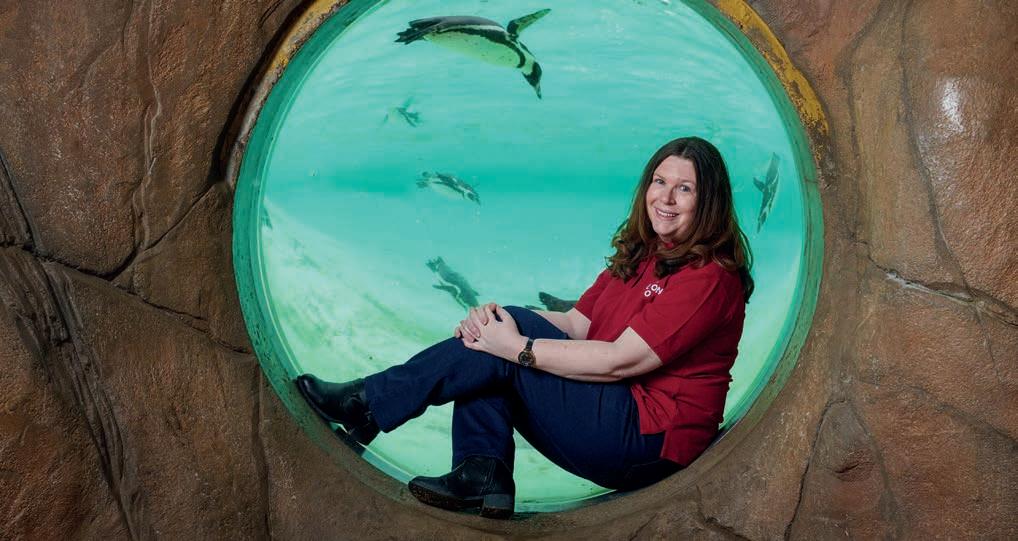
Jo’s leap into volunteering at London Zoo feels like fate may have had a hand in it. “I met up with an old school friend, who suggested we go to the Zoo together. I wasn’t an animal person especially, but it was the squirrel monkey enclosure that stood out to me – or rather, the keeper standing in the enclosure, surrounded by a family of monkeys. I thought wow, what an incredible place to work.
“Out of curiosity I went on the Zoo’s website to see what jobs there were. And it happened that there was a volunteer role, and it included supervising the squirrel monkeys.”
The rest, as they say, is history. “That was summer 2010, and I became a volunteer the same year. I’m normally an indecisive person but I acted fast to meet the job advert deadline. And I’m so glad I did!”
Today, you’ll find Jo in a red uniform, patrolling one of the animal walkthroughs at the Zoo – the squirrel monkey enclosure, Rainforest Life, Butterfly Paradise, Monkey Valley (to name a few) – eager to share the knowledge she’s gained over 13 years as a volunteer. “It gives me such satisfaction seeing a smile on a visitor’s face when they walk away,” says Jo. “I enjoy helping other people
“I can’t imagine what my life would be like now if I hadn’t discovered the Zoo. Volunteering has given me so much confidence.”
learn – that’s what I’m all about really.” Which might also explain Jo’s chosen profession – by day, Jo works as a librarian at a school.
“I most enjoy telling people about all the work London Zoo does behind the scenes,” she says. “For example, how breeding programmes work – how we collaborate with other zoos and the research and genetic analysis that goes into breeding zoo animals to ensure a healthy zoo population.
“And then there’s all the work ZSL is doing around the world that people aren’t aware of. Just take the scimitarhorned oryx – they were practically extinct, but ZSL has helped to bring them back from the brink.” (See page 4 for more on the oryx.)
Jo says she now sees herself as an ambassador for the Zoo, but things could have been so different. “I can’t imagine what my life would be like now if I hadn’t discovered the Zoo. I used to be quite shy but volunteering has given me so much confidence – and my hobbies are so focussed around it.”
Jo’s time at the Zoo inspired her interest in photography, and has added to her social life too. “A group of us regularly visit other zoos, and I’ve been to so many weddings!” she laughs. “I even saw the Queen and Prince Philip once, when they opened the elephant centre in 2017. I felt so privileged to be there.”
“I remember, when I applied for the role, I wondered if I really wanted to give up my Saturdays. Thirteen years later, I say to anyone who will listen – friends, family, people at work, or visitors – ‘keep an eye on the website, it’ll be the best decision you’ll ever make’.”
We want to hear more of your stories! Get in touch at wildabout@zsl.org to share your experience of being a part of ZSL.

9 WILD ABOUT / SPRING 2024
Jo Iredale tells Wild About why volunteering at London Zoo has changed her life
ONE OF JO’S PICTURES SQUIRREL MONKEYS OF TWO YOUNG
THINGS TO DO THIS SEASON

1
ZOONORMOUS EGG HUNT
LONDON AND WHIPSNADE ZOOS
29 MARCH – 14 APRIL
Treasure hunters, have your spyglasses and codebreakers at the ready – an Easter egg hunt is coming to London and Whipsnade Zoos this spring. Giant eggs have mysteriously been hidden around the Zoos and we need your help to follow the trail, collect the clues about egg-laying animals and crack the code. Successful codebreakers will receive a prize for completing the trail, and there will be an eggthemed touch-table and craftmaking for little hands.
THE SECRET LIFE OF REPTILES AND AMPHIBIANS OPENS
LONDON ZOO 29 MARCH
Meet your old favourites and some new species in our new conservation centre for reptiles and amphibians. Watch our Philippine crocodile dive underwater in his new home, catch up with our Chinese giant salamanders, and meet newbies like the Mangshan viper, our Lake Titicaca water frogs – the largest aquatic frog in the world – and the mountain chicken frog, one of the world’s rarest. Gold members will be invited to exclusive exhibit previews between 16-24 March, keep an eye out for your email invite.
2


3
MONKEY FOREST OPENS
WHIPSNADE ZOO 29 MARCH
Pass through Monkey Forest’s gate into the home of our swinging langurs, chattering macaques, miniature water buffalo and snuffling babirusa! Monkey Forest incorporates a woodland of over 100 trees and is built to give unrivalled viewing for visitors, with sunken fences and raised viewing spots along the trail for uninterrupted views of our new species. Keep an eye on your inbox for your invitation to our Gold member previews between 18-24 March.
FIND OUT WHAT’S ON AT OUR ZOOS
10 WILD ABOUT / SPRING 2024 VISIT
Strap yourselves in for a bumper spring at the Zoos. We’re celebrating two animal-home openings and there are giant egg hunts at both Zoos for your little Easter bunnies. Pop our dates in the diary so you don’t miss out and keep an eye on member emails for updates and timings.
WORLD PENGUIN DAY
LONDON AND WHIPSNADE ZOOS
27 AND 28 APRIL
Wonder at your favourite waddlers this April and celebrate all there is to love about penguins on World Penguin Day. Why don’t they fly? How are they so acrobatic in the water? Do they mate for life? We have all the answers and, more importantly, we can also tell you humans what you can do to help penguins in the wild. Join us at London and Whipsnade Zoos for penguin-themed talks, arts, crafts and competitions.


LOVE YOUR ZOO WEEK
LONDON AND WHIPSNADE ZOOS
25 MAY – 2 JUNE
SAVE THE DATES
Tear me out and stick me next to your calendar or on the fridge
INTO THE DRAGON’S DEN
LONDON ZOO
Learn how to train a dragon like Khaleesi (like Dragon Keeper Joe Capon, on page 12) alongside one of our expert dragon keepers. Guests will go behind the scenes into the Komodo dens to help out with enclosure checks, cleaning, making scent trails and giving Khaleesi one of her two main feeds a month. Gold members, Fellows and Patrons receive 10% discount on all of our animal experiences.
4 5 6
If you’re receiving this magazine, chances are you already love your Zoo. So you’re in luck, because this spring we’re taking part in national ‘Love Your Zoo Week’, celebrated by zoos and aquariums across Britain and Ireland. We’ll be taking the week to celebrate what makes our Zoos special, from Extinct in the Wild species and their recovery programmes, to native species habitats at Whipsnade. Join us for themed talks, craft-making, animal bingo and competitions throughout the week.

LONDONZOO.ORG/WHATS-ON AND WHIPSNADEZOO.ORG/WHATS-ON
11 WILD ABOUT / SPRING 2024
HOW TO TRAIN A DRAGON
Dragon Keeper Joe Capon on bonding with London Zoo’s recent arrival, Khaleesi the Komodo dragon

She’s a portal into the past, when extinct giants still existed. It’s like going to work with a dinosaur every day.”

“She’s really quite friendly.” These might not be the words you’d expect someone to use about a Komodo dragon, but it’s how Joe Capon, who has possibly the coolest job title at London Zoo (Lead Dragon Keeper), describes Khaleesi.
“Other dragons will hiss or puff when you get too close. They tend to be quite grumpy. But Khaleesi is very relaxed, very balanced.” Not much like her Game of Thrones namesake, then.
After working with Ganas for many years, London Zoo’s previous Komodo dragon, Joe has found Khaleesi to be a very different dragon. “Male dragons like Ganas have an inherent swagger – a domineering behaviour that is intended to be a little intimidating. Khaleesi is super curious and alert, but she’s also calm with me. It sounds weird to say, but she’s nice.” Khaleesi will often lie on her tummy with legs spread forwards and backwards, just like a terrier, when he is in the enclosure with her, says Joe.
A portal into the past
“There was never a moment when I decided to like reptiles. I’ve been obsessed with them as far back as I can remember,” says Joe. He puts some of his enthusiasm down to Steve Irwin, whose affection for reptiles was infectious. But it was his mum who helped him nurture it. “Looking back, I feel a bit bad for Mum,” Joe laughs. “There’re not many parents who would want deadly snakes in the house! But she was so
Working with Khaleesi is the realisation of a childhood dream, says Joe. “She’s a portal into the past, a lost land, when extinct giants still existed. It’s like going to work with a dinosaur every day.”
Working with a dinosaur “Interacting with Khaleesi is the best part of my day,” says Joe. “When you’re sharing her space, suddenly nothing else matters. I can see in her eyes, the way she looks at me, a

12 WILD ABOUT / SPRING 2024


rewarding, says Joe. Building trust is also integral to caring for Khaleesi. She has ultrasounds three times a year to check her reproductive health, so Joe trains her to voluntarily go into a crate, have blood samples taken from her tail and undergo an ultrasound exam –all without an anaesthetic and the potential stress that could cause.
And how do you build trust with a dragon? “It’s a very gradual process over several months,” says Joe. “Luckily, Komodo dragons are a very food-motivated species, with a fast metabolism, so they want to eat all the time. That means we can use

DRAGON DELIGHTS
Keeping Khaleesi stimulated and challenged is a big part of Joe’s work with her. Here are just some of the things he does throughout the week.
Scent trails
LAND O F GIANTS
Thousands of years ago, our planet was populated by many giant animal species like the Komodo dragon. Most have disappeared now, and one theory is that humans or climate change drove them to extinction.
The process of training a dragon begins with simply walking in their enclosure, three times a week, for 15 minutes each time. “When she’s relaxed around me, we’ll begin recall training – which lets me call her into the inner den so that I can clean her enclosure. When she’s happy with that, we move onto target training, which for her means coming to or following a coloured ball on a stick.
“Eventually we introduce her to the crate and build her positive association with the crate, using food. The aim is for her to recognise the crate as a safe space, with happy memories.”
From just walking in the enclosure to being able to take a blood sample from their tail took a full two years with Ganas, says Joe, but he expects Khaleesi to get there must faster.
“She’s just so good natured.”
The key to a dragon’s heart isn’t gold, it seems, it’s patience – and plenty of treats.

Komodo dragons primarily hunt by smell, using scent receptors on their forked tongues to detect prey. Laying scent trails around the enclosure, using blood or animal fur, stimulates Khaleesi’s predatory instincts. Joe also uses novel scents, like lemon balm or thyme.
Rainfall
Indonesia, where Komodo dragons originate, experiences a rainy season every year. “We regularly simulate a heavy rainfall in Khaleesi’s habitat,” says Joe. “As well as the water itself, the rain releases smells from the ground and knocks things off the trees – creating new scents for her to explore.”
Mealtime
“There’s nothing worse than an animal scoffing down their meal in two minutes flat,” says Joe. “We want Khaleesi to work for her food, so we often hide it in a tree or underground. We also regularly give her a whole carcass –chicken, trout, duck, or even deer – which she has to work hard to eat.” Dragons are strict meat eaters, which means they rely on the meat, bones and organs of their prey for minerals and vitamins.

13 WILD ABOUT / SPRING 2024
Tiger numbers in Nepal have doubled in the last decade, thanks to the Nepalese Government and the support of charities like ours. But tiger conservation isn’t just about tigers. It’s about people too.
Better protection for tigers and their habitats has seen Nepal’s Bengal tiger population grow from just 121 in 2009, to 355 in 2022. We’ve been working in Nepal for 30 years to support the Government’s mission to boost its wildlife populations, supporting the funding and training of Nepal’s forest rangers.
The success of Nepal’s tigers is intertwined with the future of Nepal’s rural and indigenous communities, who live on the edges of protected areas and share their habitat. An important part of saving tigers is ensuring that local people have the tools and support they need to live happily alongside them, particularly as tiger numbers start to grow.
That means protecting livestock from tigers, by building predator-proof enclosures for cattle and poultry. It means helping farmers adopt more sustainable practices and helping communities start local businesses so that they are less reliant on the forest for household needs, like firewood and food. And it means supporting better relationships between communities and the conservation and government agencies working in the national parks.
We work in four of the national parks where the majority of Nepal’s tigers live, as well a protected area in northern India. Since our community-based programmes began, we have helped over 3,000 people access career training or financial support, helping tiger numbers continue to grow.
776 20162022
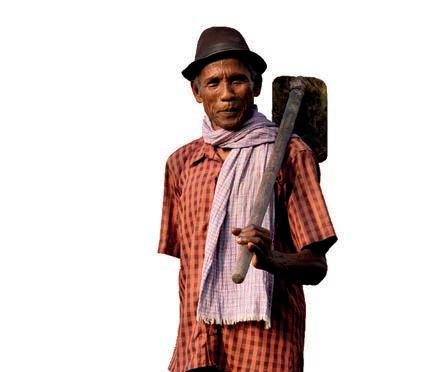
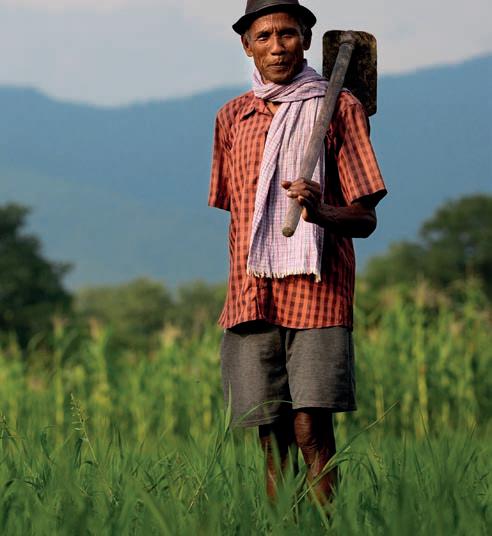

Nandhaur Wildlife Sanctuary
Tiger Population People who accessed training or financial support
33 11 1 WILD ABOUT / SPRING 2024 14


1.
2.
We’re still learning so much about tiger behaviour. Tigers were previously thought to be solitary animals, but our research on Amur tigers (found in the Russian Far East) and the evidence we secured on camera traps proved that some male tigers stick around with mum and their cubs.


Growth in tiger population where we work1
Shows tiger population growth in five protected areas where we work.
FACT FILE
With exception of tiger census in Nandhaur Wildlife Sanctuary, which took place in 2016.
ali Lumbini
NEPAL Bardia National Park Banke National Park Chitwan National Park 823 463 409 125 25 128 50 4 20142022 20142022 20142022 3 4 5 5 Shuklaphanta National Park 657 36 20142022 2 93 17 a 15 WILD ABOUT / SPRING 2024 20142 2022 202 347
Gandaki Bagmati Madhesh Koshi
SPRING CLEAN
Brooms at the ready! Man the feather dusters! Prime the kitchen cloths! It’s time for a spot of spring cleaning. And why not look to the animal kingdom for your inspiration?
GRIME FIGHTERS
NOTFOR GROWN UPS!
JOKE What do you call a bear caught in a spring shower? A drizzly bear
JOIN THE DOTS
Big cats are some of the world’s cleanest creatures. They spend several hours grooming each day, using their tongues to remove dirt and parasites. It’s also an important bonding activity between family members. Unfortunately, Whipsnade’s male lion Malik has fallen in a muddy puddle. Can you help to clean him by joining the dots to reveal the lion?
DID YOU KNOW?
Okapi tongues are so long (30cm) that they can use them to clean their ears, nose and Delicious!eyeballs.
DID YOU KNOW?
Some small animals, including birds, fish and shrimp, have evolved to feed on the parasites and algae that live on larger animals, like rhinos or sharks.
It’s not just our Sulawesi crested macaques who groom themselves – lots of animals do it to stay healthy. Even tortoises rub themselves against rocks and branches to keep their shells clean. Can you name some of the animals who keep clean in the crossword below?
2
WILD ABOUT / SPRING 2024 16
1 2 3 4 6 5 7 8 9 10 1 2 3 4 5 6 7 8 57 56 55 9 10 11 12 51 53 52 54 13 14 15 48 49 50 16 17 18 19 20 21 22 23 24 25 26 27 28 29 30 31 32 33 34 35 36 37 38 3940 41 42 43 44 45 46 47
1
3
6 7 9 5 10 ANSWERS: 1)
2)
4 8
Gibbon
Parrot 3) Wild Dog 4) Gorilla 5) Tortoise 6) Lion 7) Flamingo 8) Tiger 9) Chimpanzee 10) Bee
HAPPY AS A HIPPO
Hippos spend around 16 hours a day soaking in rivers and ponds, so you might think that the common and pygmy hippos at our Zoos are the cleanest animals in the world. Or you might, if it wasn’t for one thing: their unusual pooing technique. When they go to the toilet, hippos flick their tails rapidly back and forth, sending their poo spraying in all directions! They do this to mark their territory. Think about that before you consider inviting a hippo to your house for a sleepover.
Send us a picture of your colourful creation to be in with the chance of winning a cuddly hippo from the ZSL shop! Ask a grown up to take a picture of your entry and email it to us at wildabout@zsl.org with your name, age and postal address by 1 June 2024. Email the same address for full terms and conditions.

17 WILD ABOUT / SPRING 2024

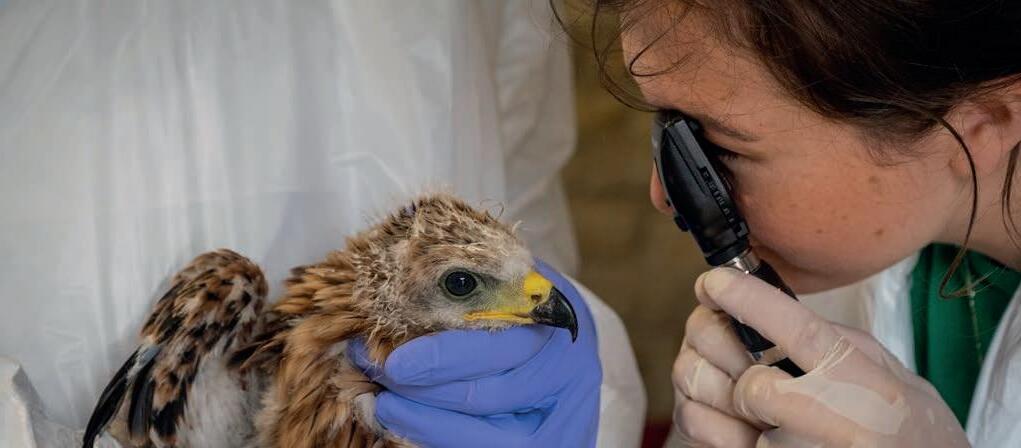
WILD LIFE
BECOMING A VET...
Wasn’t a childhood dream like it is for some people, though I’ve always loved animals. Someone suggested it to me as a career path when I was 16 years old and it became stuck in my mind. From that point on it became my sole goal.
I VOLUNTEERED A LOT…
In fact, I don’t think I had a free school holiday from that point on. Alongside doing my A Levels, which included Biology and Chemistry, I was constantly volunteering at veterinary clinics, at farms during lambing season, at dog kennels. I even spent three weeks at a pig farm.
ONCE I GRADUATED FROM VET SCHOOL…
I spent a couple of years working in a vet clinic, treating dogs, cats and other pets. But I was desperate to work with wild animals. I wanted to find a way to use what I’d learned at vet school to impact conservation in some way. Luckily, I found DRAHS at ZSL.
DRAHS STANDS FOR…
Disease Risk Analysis and Health
Surveillance. We are a team of vets and biologists who safeguard the health of wild animals that are being moved from one place to another for the purposes of conservation, as well as the health of the wider ecosystem they’re being released into. For example, when the UK Government decides to reintroduce a species, like dormice (which have disappeared from a lot of the UK) we work with them to reduce the risk of disease to these wild animals, other animals at the release site and the wider ecosystem.
WILD ANIMALS HAVE ADAPTED TO LIVE WITH THE PARASITES…
Found in their local area over thousands of years. But if we start moving animals from one location to another, like from mainland Europe to England, we risk introducing parasites that could cause disease in the wildlife we have here. Or, those animals from elsewhere could be unable to cope with the parasites found in England. It’s our job to prevent that.

I WORK ALL OVER THE UK…
From the marshy waterways of Kent, where we’re assessing the health of wild beavers, to forests in the Midlands, where we’re helping with the reintroduction of dormice. I also get sent to some very odd locations – I recently performed
I recently performed a health examination on several white-tailed eagles at an airbase a health examination on several white-tailed eagles at an airbase in Northamptonshire. They were being moved from Scotland, to the Isle of Wight, where they are locally extinct.
BRITISH WILDLIFE DOESN’T GET THE ATTENTION IT DESERVES…
We have some incredible species, from birds of prey to sand lizards, and they play an important part in British culture. And the truth is that, while a lot of the focus is on exotic wildlife, the UK is one of the most wildlife-depleted countries on the planet. We’re really on the frontline of conservation!
LYING IN A PUDDLE OF MUDDY WATER…
Taking a blood sample from the tail of a beaver might not sound glamorous, but our work will help to inform the UK Government on how to safely reintroduce beavers to England. Beavers are ecosystem engineers, and their presence will be a huge boost for biodiversity.
ONE OF THE BEST PARTS OF MY JOB…
Is being there at an animal release. Knowing that animal is going out into the wild to help grow their population is very special. It’s the culmination of a lot of work, research, and trips up and down the motorway!
 Sophie Common describes her journey to becoming a wildlife veterinarian at ZSL and being part of a team focussed on the restoration of British species
Sophie Common describes her journey to becoming a wildlife veterinarian at ZSL and being part of a team focussed on the restoration of British species
WILD ABOUT / SPRING 2024 18
DON’T FORGET
Gold Members can grab 10% discount in our shops and on experiences using code SUNBIRD10

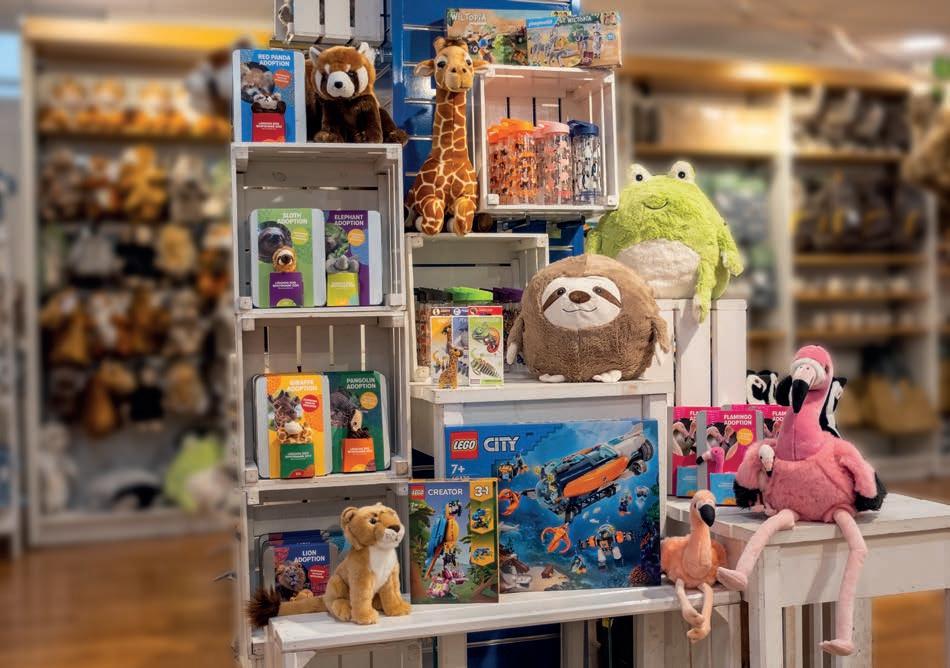
SPRING PICKINGS
Take home a slice of the Zoos with you this Easter, spoil a loved one or help care for our animals with one of our adoption packs. Every purchase from our shop supports our Zoos and our work protecting animals around the world. shop.zsl.org
ADOPT AN ANIMAL
For those who love lions, are passionate about pangolins or fanatical about flamingos, adopt one of our ZSL species and support our conservation work (£25). Adopters will receive a personalised certificate of adoption and a gift set of goodies, including a soft toy, pin badge and information booklet. For the full list of adoptable species, visit shop.zsl.org
CREATE YOUR OWN ANIMAL KINGDOM

When April showers strike, retreat inside and create your own animal kingdom with one of our play or craft sets. Build the perfect bookcase ornament with our eco-friendly 3D animal models (£9 each). Marvel at Playmobil’s Wiltopia playsets, made from more than 80% sustainable materials (from £20). Or dive in with the Lego Deep-Sea Explorer submarine set (£95), complete with science lab, sea creatures and diving suit!
TAKE HOME YOUR FAVOURITE
What better way to remember a visit to the Zoo than to take home your favourite animal? Our range of soft toys is over 100-strong, including giraffes, lions, red pandas and flamingos (from £20). And look out for our new range of cushies, including sloth, frog and penguin (£25 each). These cushion-shaped animals are perfect for snuggling on the sofa.
TAKE A SIP OF ZSL ON THE GO
Take London and Whipsnade Zoos on your travels this spring with our exclusive animal water bottles. Coming in 10 designs – including penguin, tiger and gorilla – our reusable water bottles are a great way to cut down on single-use plastic. Recyclable, PET and BPA free, you can drink safely while being kind to the environment.
19 WILD ABOUT / SPRING 2024



AROUND THE WORLD IN 30 DAYS


REGISTER INTEREST











 Matthew Gould, CEO, ZSL
Matthew Gould, CEO, ZSL























































 Sophie Common describes her journey to becoming a wildlife veterinarian at ZSL and being part of a team focussed on the restoration of British species
Sophie Common describes her journey to becoming a wildlife veterinarian at ZSL and being part of a team focussed on the restoration of British species








